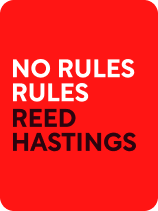

This article is an excerpt from the Shortform book guide to "No Rules Rules" by Reed Hastings. Shortform has the world's best summaries and analyses of books you should be reading.
Like this article? Sign up for a free trial here .
What is the Netflix Keeper Test? How can it provide a measure for deciding what employees should be retained and who should be let go?
The Keeper Test is a measure used by managers at Netflix to regularly reassess every employee on their teams. If a person said they were leaving for another job, you ask yourself if you would fight to keep them. If you wouldn’t, you should consider firing them.
Read on for more about the Netflix Keeper Test and how it works.
Fire Any Employee You Wouldn’t Fight to Keep
If your company is growing, that success is likely built in large part on the high talent density you’ve already established. Thus, it’s critical to keep that talent density high to continue your success. Achieving and maintaining high talent density isn’t just about hiring well—it’s also about firing good employees to make room for great ones. Netflix keeps talent density high by encouraging managers to use the “Keeper Test” to regularly reassess every employee on their teams. When a manager does the Keeper Test, she asks herself whether she would fight to keep a particular employee if that employee told her that he was leaving for another job. If the manager wouldn’t fight to keep the employee on the team, then the manager should either talk to the employee about how he can improve or offer him a generous severance package.
Hastings believes that each employee should remain in their position only as long as the employee is the best person for the job and the job is the best fit for the employee. Someone may be the perfect match for a job when she starts, but over time that can change:
- The employee’s skills may not grow as much as they need to, or they may grow in a different direction.
- The company’s needs may change, and the employee may not be able to fill them.
Despite the benefits of keeping the talent density high, it can be difficult for managers to fire employees that they otherwise like and respect, and who may be doing a perfectly adequate job. However, managers must understand that everyone at the company benefits when everyone at the company is the best possible person for their position. Along with the Keeper Test, managers should ask themselves whether the company as a whole would be better off if a particular employee was fired.
Many companies try to avoid turnover because it’s expensive to hire and train new people—but that makes it more likely that people will stay in positions because of convenience rather than performance. By contrast, Hastings’s priority is that each position is filled by the best possible person. And his approach seems to be paying off: Despite the seemingly ruthless policy, Netflix has a lower voluntary turnover rate (people quitting their jobs) than the average for American companies, and an involuntary turnover rate (people getting fired) that’s two percentage points above average. The total turnover rate—combining voluntary and involuntary—is 11 to 12 percent, which is:
- Below the 18 percent average for all American companies
- Slightly below the 13 percent average for tech companies
- On par with the 11 percent average for media and entertainment companies
Prevent Internal Competition and Fear of Firing
Many companies try to achieve a high talent density, but they use problematic tactics. One common strategy is stack ranking (also called a “vitality curve” and “rank-and-yank”), in which managers regularly rank their employees from top to bottom, and the lowest-ranked employees are fired. Stack ranking judges each employee’s performance relative to her coworkers’ performance, which creates internal competition among employees—if one person does well, her teammates’ rankings drop by comparison. As a result, collaboration suffers and employees don’t get to enjoy the benefits of working in an environment full of high performers.
While Netflix’s Keeper Test also calls for managers to regularly reassess their employees’ performances, it doesn’t incorporate any ranking systems or firing quotas. Since Netflix doesn’t have a fixed number of positions it needs to fill, one employee’s success doesn’t come at the price of another employee’s loss. In fact, when every employee is successful, the team accomplishes more, which allows the company to grow and create more positions for more high-performing talent. This mentality allows collaboration to flourish as employees focus on competing with other companies instead of with each other.
Still, Netflix’s strict performance standards can cause employees to feel that the possibility of being fired is an ever-present threat. While this fear can motivate employees to work tirelessly in order to keep their jobs, Hastings recognizes that people do their best work when they’re inspired by passion, not fear. In order to minimize anxiety among employees, Netflix uses two strategies.
First, the company encourages employees to use the Keeper Test Prompt when they’re feeling unsure about their standing. In a one-on-one meeting, a nervous employee should ask her manager whether she would pass the manager’s Keeper Test—in other words, how hard would the manager fight to keep her if she told the manager she was leaving? The manager can respond in one of three ways:
- “I would fight hard to keep you.” If this is the answer, the employee can rest assured that her job is safe.
- “I would fight harder if you improved in these ways.” This answer can be difficult to receive, but the employee still benefits because she has the opportunity to use the manager’s specific feedback to improve her performance.
- “I would not fight hard.” The possibility of hearing this answer is scary enough to deter some employees from asking the question in the first place. However, if this is the case, it gives the employee and manager a chance to talk about whether the employee is still the best fit for the job (and vice versa), and it prevents the employee from being blindsided if she is subsequently let go.
Second, managers hold a post-exit Q and A session with employees after someone is fired. Whenever an employee is fired, the people on that person’s team are left wondering what happened, whether or not their former coworker saw it coming, and if they could be next. In these post-exit Q and A sessions, managers can be open about what happened, which alleviates employees’ fears.
Exercise: Employee—Would You Work Somewhere With a “Keeper Test”?
Consider the pros and cons of working for a company that uses the “Keeper Test,” which managers use to determine if they should fire an employee based on whether or not they would fight to keep the employee at the company.
- If you were applying for a dream job at Netflix and found out about the practice of firing and giving generous severance packages to adequate employees, how would that impact your interest in the job?
- If you would be hesitant to join the company because of this practice, what would be your main concern?
- What—if anything—appeals to you about working in an environment with this practice? (For example, maybe you value the opportunity to work with all high-performing colleagues.)
- At your current job, how does your level of job security impact your performance?

———End of Preview———
Like what you just read? Read the rest of the world's best book summary and analysis of Reed Hastings's "No Rules Rules" at Shortform .
Here's what you'll find in our full No Rules Rules summary :
- How Netflix achieved massive success in a short period of time
- The unusual business practices that have helped Netflix sustain its success
- Why Netflix fires adequate employees






